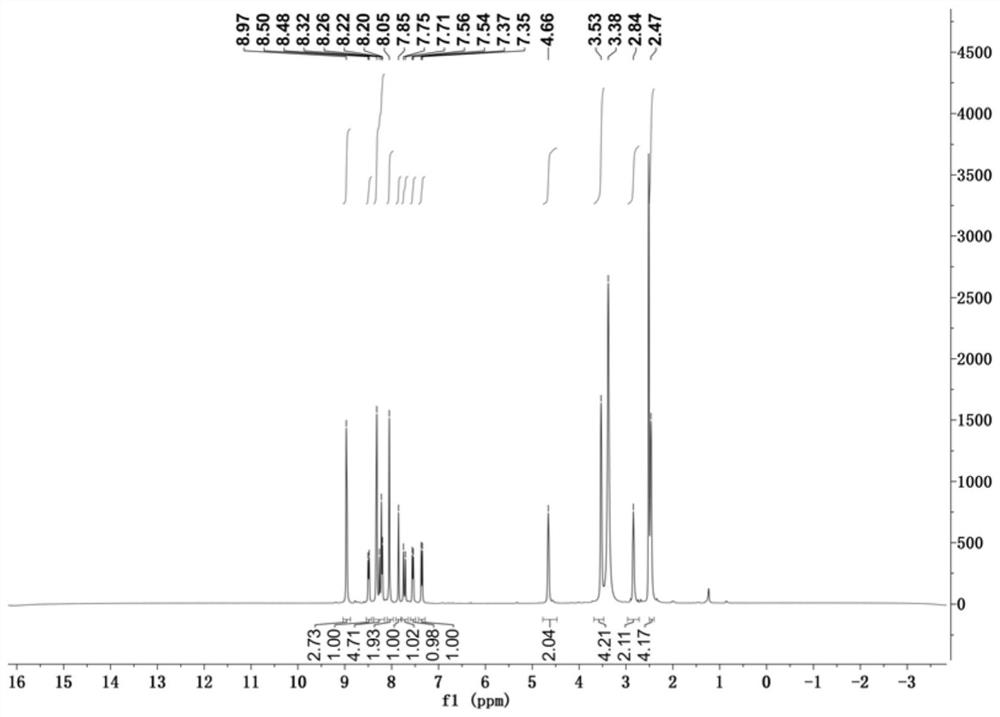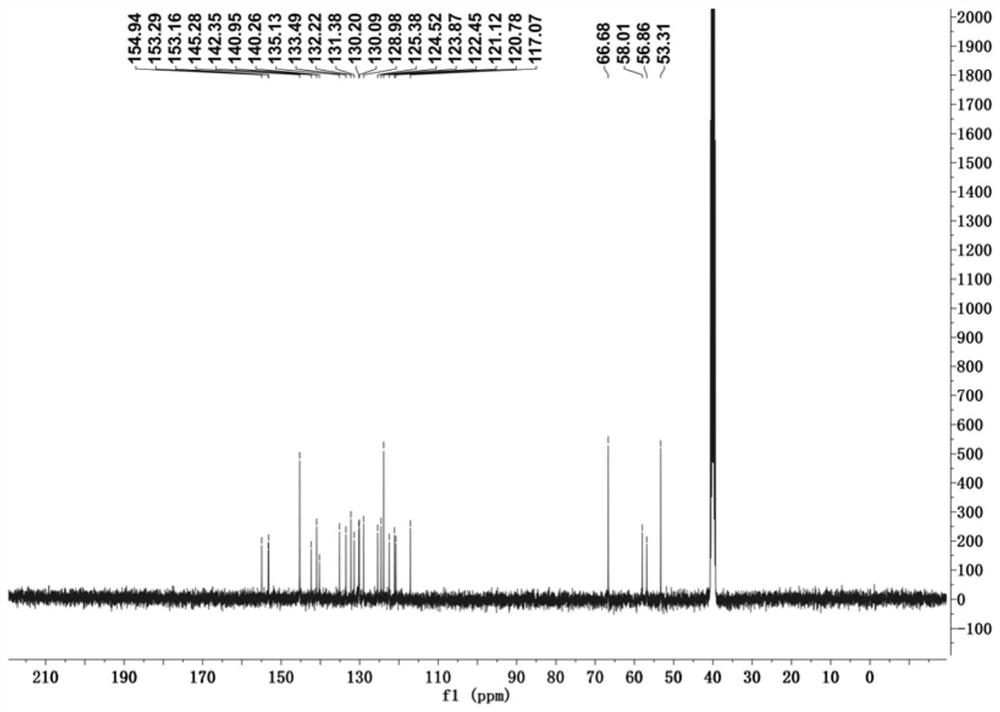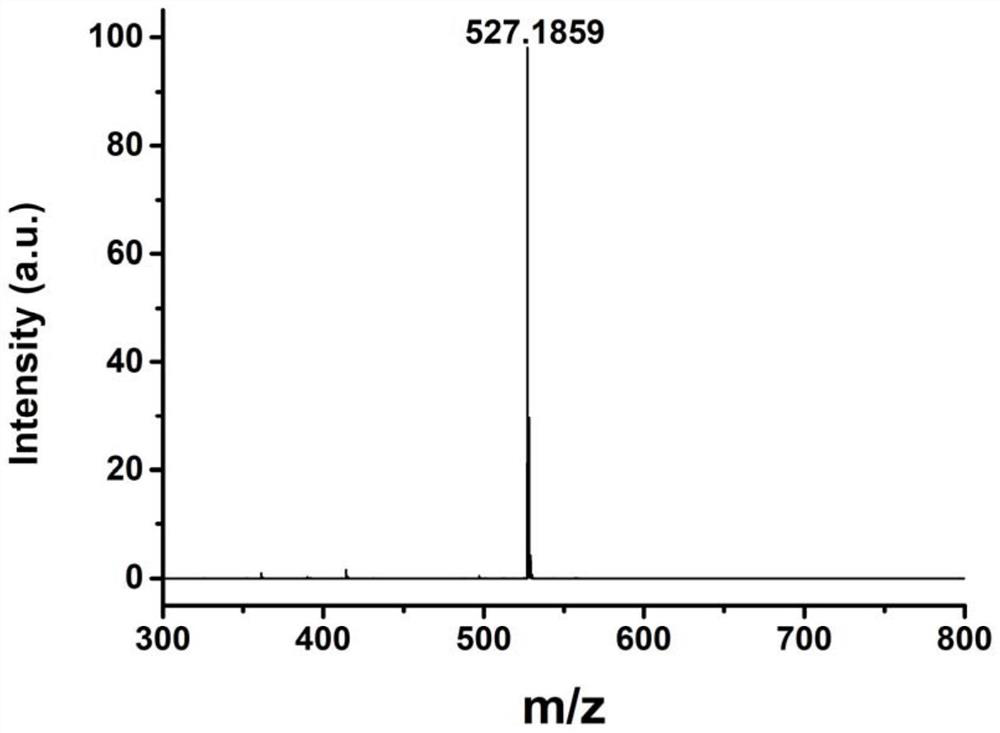Application of morpholine-pyridine-merocyanine derivative as hydrogen sulfide fluorescent probe
A technology of fluorescent probes and derivatives, applied in fluorescence/phosphorescence, luminescent materials, organic chemistry, etc., can solve the problems of limited practical application, not many hydrogen sulfide fluorescent probes, and inability to recognize hydrogen sulfide, and achieve wide application value , the effect of easy availability of raw materials, simple synthesis and post-processing methods
- Summary
- Abstract
- Description
- Claims
- Application Information
AI Technical Summary
Problems solved by technology
Method used
Image
Examples
Embodiment 1
[0029] The preparation method of the morpholine-pyridine-merocyanine derivative fluorescent probe of this embodiment is as follows:
[0030]4.41 g, 4-[2-(6-hydroxy-2-naphthyl)-vinyl]-1-[2-(4-morpholinoethyl)]-pyridine bromide (10 mmol) and 2.23 g 2,4-Dinitrofluorobenzene (12 mmol) was dissolved in 0.2L of acetonitrile, then 2.77 g of anhydrous potassium carbonate (20 mmol) was added, and the reaction was stirred at room temperature for 3-4 h. After the reaction was completed, the reaction liquid was rotary evaporated. The obtained solid was washed with ethyl acetate, and then recrystallized with absolute ethanol to obtain the fluorescent probe of the morpholine-pyridine-merocyanine derivative. The yield of the target product was 67%.
[0031] Adopt nuclear magnetic resonance instrument to carry out nuclear magnetic resonance analysis to the morpholine-pyridine-merocyanine derivative that makes, the result is as follows:
[0032] 1 H NMR (400 MHz, D 2 O), δ (ppm): 8.97 (s, ...
Embodiment 2
[0036] Morpholine-pyridine-merocyanine derivatives on HS − Determination of optical properties of
[0037] The morpholine-pyridine-merocyanine derivatives prepared in the above example 1 were used as fluorescent probes in HEPES buffer solution (0.05 mol / L, pH=5) to prepare a molar concentration of 1×10 -5 mol / L solution, respectively, at a molar concentration of 3×10 -5 mol / L anion (OAc − 、Br − , Cl − , ClO − , I − , F − , PPi, H 2 PO 4 − 、HPO 4 − 、PO 4 3− 、HS − 、HSO 3 − 、HSO 4 − , SO 4 2 − , S 2 o 3 2− , S 2− and SO 3 2− ) or amino acid (Ala, Hcy, Cys) solution, add the same amount of the above fluorescent probe solution, and use the fluorescence spectrometer to analyze (excitation wavelength is 370 nm), the obtained fluorescence spectrum is shown in Figure 4 . pass Figure 4 It can be seen that the morpholine-pyridine-merocyanine derivatives prepared by the present invention are only suitable for HS as probes − With obvious response, the cha...
Embodiment 3
[0040] Fluorescent Probes of Morpholine-Pyridine-Merocyanine Derivatives in Intracellular HS − detection experiment
[0041] 1 x 10 for HeLa cells -5 mol / L of the morpholine-pyridine-merocyanine derivative fluorescent probe prepared in Example 1 above and the commercial lysosome localization dye LysoTracker Blue were co-incubated at 37°C for 30 minutes to obtain the fluorescence imaging image of HeLa cells , specifically as Figure 6 As shown, where: where: a is the fluorescence imaging image of the blue channel; b is the fluorescence imaging image of the green channel; c is the superimposed picture of the blue channel and the green channel; d is the intensity correlation map of the blue channel and the green channel; f Overlay of blue and green channel intensity distributions across a single HeLa region. From Figure 6 It can be seen that the fluorescence of the green channel of the probe in HeLa cells is basically consistent with the fluorescence of the blue channel of ...
PUM
 Login to View More
Login to View More Abstract
Description
Claims
Application Information
 Login to View More
Login to View More - R&D
- Intellectual Property
- Life Sciences
- Materials
- Tech Scout
- Unparalleled Data Quality
- Higher Quality Content
- 60% Fewer Hallucinations
Browse by: Latest US Patents, China's latest patents, Technical Efficacy Thesaurus, Application Domain, Technology Topic, Popular Technical Reports.
© 2025 PatSnap. All rights reserved.Legal|Privacy policy|Modern Slavery Act Transparency Statement|Sitemap|About US| Contact US: help@patsnap.com



